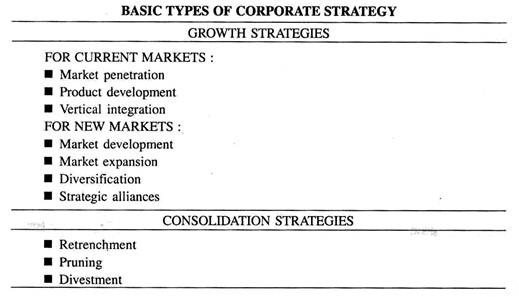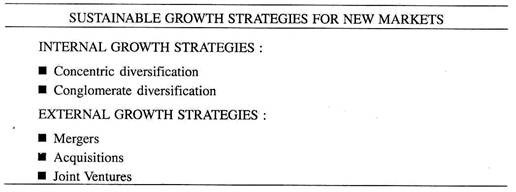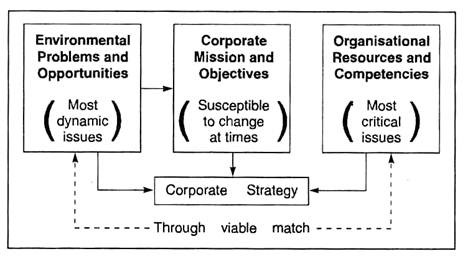In this article we will discuss about:- 1. Meaning of Corporate Strategy 2. Strategy Selection 3. Types 4. Environment Vs. Organisation.
Meaning of Corporate Strategy:
A corporate business enterprise nowadays is a part of the nation, of a country and of the Globe. It has to undertake its business activities most firmly and promptly keeping in view the international scene characterised by rapid technological changes, quickened pace of innovation, and fierce competition from other enterprises, so as to maintain its stability and growth.
And so, it has to incorporate within it certain business strategies and policies and plans, as the directional action decisions. This would articulate its interrelationships between it and its external environment and enable it to remain ahead of its competitors— operating inside and outside of a country.
Concepts of strategic management and their implementation are of great importance in the global scenario so presented. Strategic management is the only means by which a progressive management of a company can anticipate future opportunities and problems that are conducive to greater harmony and goal congruence.
Strategy Selection:
The basic purpose of a company that spells out and practices the things like ‘what strategy to pursue’, ‘how to pursue’, ‘where to pursue’, and ‘when to pursue’ is the content of corporate strategy.
ADVERTISEMENTS:
In this sense, the subject of strategic management in relation to a business unit has practical connotations and requires pragmatic decisions of a strategist. A strategist should understand that each strategy and its selection is a complex decision making process.
He must realise that:
1. In each state of strategy selection and development, a major problem in hand generates sub-problems and requires application of criteria like intelligence, design, and choice;
ADVERTISEMENTS:
2. There is no simple analytical model upon which basic strategic choices are made;
3. A large number of disciplines (e.g., ethics and value-systems, individual behaviour, organisation behaviour, internal and external environment, technical and economic analyses, etc.) and associated sub-disciplines influences and interacts on strategic decision making;
4. There are no neat formulas to quantify and determine how much of each of the aforesaid disciplines will apply to a particular problem situation nor how much weight he should give to each of the disciplines; and
5. From company to company and within the same company, the strategy-related decision process constantly changes and major strategic decisions tend to be, in most cases, unique to each organisation.
ADVERTISEMENTS:
That is why, the determination of ‘what-how-where-when’ of a strategy or a set of strategies and policies to be followed in the face of stern realities of the business world is not an easy task.
Types of Corporate Strategy:
Organisations have two fundamental directions in which to proceed when selecting a corporate strategy: growth or consolidation. Traditionally, organisations have pursued growth strategies, even when sales growth was not the primary corporate objective.
Essentially, a growth strategy is one in which sales growth (usually from new products and markets) becomes a vehicle for achieving stability or enhanced profitability.
In recent years, however, both large and small organisations throughout the globe have begun to realize that unbridled and random growth can create as many problems as it solves. Consolidation strategies, in which firms seek to achieve current goals (especially enhanced profits) through non growth means, have, accordingly, become increasingly popular.
ADVERTISEMENTS:
Table below summarises the basic types of corporate strategy and shows the specific kinds of strategies in each category:
Growth strategies for current markets are not always sustainable on a long-term basis:
Growth strategies for new markets may be made sustainable on a long-term basis.
In this sense, sustainable growth strategies can be classified as:
Under the present-day scenario of globalisation and liberalisation, business units in India have got to be on their toes and they should try to compete with the best in the international arena. Unless the progressive Indian enterprises seriously adopt ‘strategic management’ as a practical concept and in a big way, they would find it extremely difficult to be competitively effective.
Summing up:
In sum, the process of developing a corporate strategy is based on
1. Examining environmental problems and opportunities,
ADVERTISEMENTS:
2. Selecting corporate objectives that are consistent with these problems and opportunities, and
3. Examining the resources and distinctive competencies that can be used in implementing the strategy.
[The diagram shown before portrays the relationship among these factors.]
Although this process appears rather simple, any number of corporate strategies are available for identification by top management. The identification and choice of a corporate strategy and/or its sub-strategies do not guarantee easy solution of a firm’s problem or situation but do assist the managers in some way or other.
ADVERTISEMENTS:
Only by understanding the different types of strategies available and the different types of strategy-related cases of different leading firms can managers of Indian firms effectively select the ones most appropriate for a particular firm’s situation.
Against this backdrop, strategy-related cases of some firms are illustrated below. After reading and seriously studying these cases, the readers will be able to appreciate and identify the ‘what-how-where-when’ involved in the pursuit of a strategy.
Environment Vs. Organisation:
The task of choosing an appropriate strategy in appropriate time is, all the more, delicate and difficult in that not all firms are equal in terms of their ability to take stock of the situations confronting them and that most managers in India are either ill-equipped to foresee or unaware of the possible impact on their firms’ product-market scope of the divergent factors influencing a corporate strategy (as outlined below):
Environmental Problems and Opportunities:
Every organisation operates in a dynamic environment that can create a variety of problems or opportunities in the firm’s existing or potential markets. Specifically, strategy managers should be aware of the possible impact on their markets of six major environmental forces.
1. Demographics, such as the age distribution of the population, birth-rates, population growth, and the regional population shifts.
ADVERTISEMENTS:
2. Social and cultural values, such as attitudes towards health and nutrition, the need for self-expression, materialism, ecological seriousness, and product safety.
3. Economic factors, including inflation and unemployment, economic growth, raw material scarcities, energy costs, interest rates, import duties, and excise.
4. Technology, particularly developing and anticipated changes that affect the kinds of products available in a market and the kinds of processes (such as automation, or the use of synthetic or substitute materials) used to produce these products.
5. Legal and regulatory actions, including the governmental regulations of the types a product, product labelling and testing, limitations regarding product contents, pollution control, and restrictions or incentives with respect to imports, exports, production, or distribution.
6. Competition, which to a large extent is a function of the other environmental forces. Specifically, both the identity of competitors and the type of focus (for example, price-oriented versus technology-oriented) of competition may change because of.
a. The entry of new firms (especially foreign firms),
ADVERTISEMENTS:
b. The acquisition of a small competitor by a large, well-financed organisation,
c. Deregulation, changing economic conditions, or new production processes that foster increased price competition, and
d. Changing social and cultural values or new technology that causes buyers to purchase products or services previously considered non-competitive (such as the renewed popularity of cloth diapers).
Examining these forces is essential to develop corporate strategies because these factors will shape the attractiveness of various businesses. Often such factors will create new opportunities or lead to the rejuvenation of mature markets.
The modern organisation must develop global assessments of the environment, as trends and developments on these six dimensions are likely to vary around each country and the globe. Because environmental changes result in changing opportunities and changing threats, they are fundamental considerations in the development of corporate strategies.
Resources and Competencies:
A second fundamental consideration in selecting a corporate strategy is whether the firm possesses the resources and competencies required to take advantage of opportunities and to avoid damaging situations.
ADVERTISEMENTS:
In developing a corporate strategy, top management should also analyse the resources that will be available to the organisation. In the broadest sense, these include.
1. Financial resources, such as cash reserves,
2. Labour and managerial skills, such as the expertise to produce high-tech products or to manage large advertising budgets,
3. Production capacity and efficient equipment,
4. Research and development skills and patents,
5. Control over key raw materials, as in the ownership of energy resources, and
ADVERTISEMENTS:
6. Size and expertise of the sales force or distribution system.
Too often firms limit their evaluation of resources to the more tangible ones, such as cash and facilities. Yet management and marketing capabilities are often more important.
For example, Britannia Biscuits’ success in its business is due primarily to effective advertising management and its extensive sales agency or force, which rotates and replenishes the stock in the retail stores. These types of competencies enhanced Britannia’s ability to continue to bring successful new products to the market place where product variety attracted the buyers.
Corporate Mission and Objectives:
In most organisations, strategic decisions are guided by statements of corporate mission and/or corporate objectives. A corporate mission describes the broad purposes the organisation serves and provides general criteria for assessing long-run organisational effectiveness.
Corporate objectives reflect management’s specific expectations regarding organisational performance. A strategist should keep in his mind that an organisation may have more than one objective at a given time. However, there is usually only one primary goal towards which the corporate strategy can be directed.
As the environment changes, organisations often modify their missions and objectives. For example, the elimination of many regulations in the banking industry and an increase in the types of financial investment products (such as Money Market Accounts) have led many firms to broaden their missions. Thus, many banks now view themselves as “financial institutions.”
ADVERTISEMENTS:
Similarly, changes in technology or the natural extension of existing technology can create an opportunity for broadening the definition of a business. The Department of Telecommunications (Govt, of India)’s business on STD, ISD and FAX is a case in point.
Also many private telecommunications firms (e.g., BPL, Siemens) are doing business in office automation, data systems, and a host of other goods and services with related technological bases.


